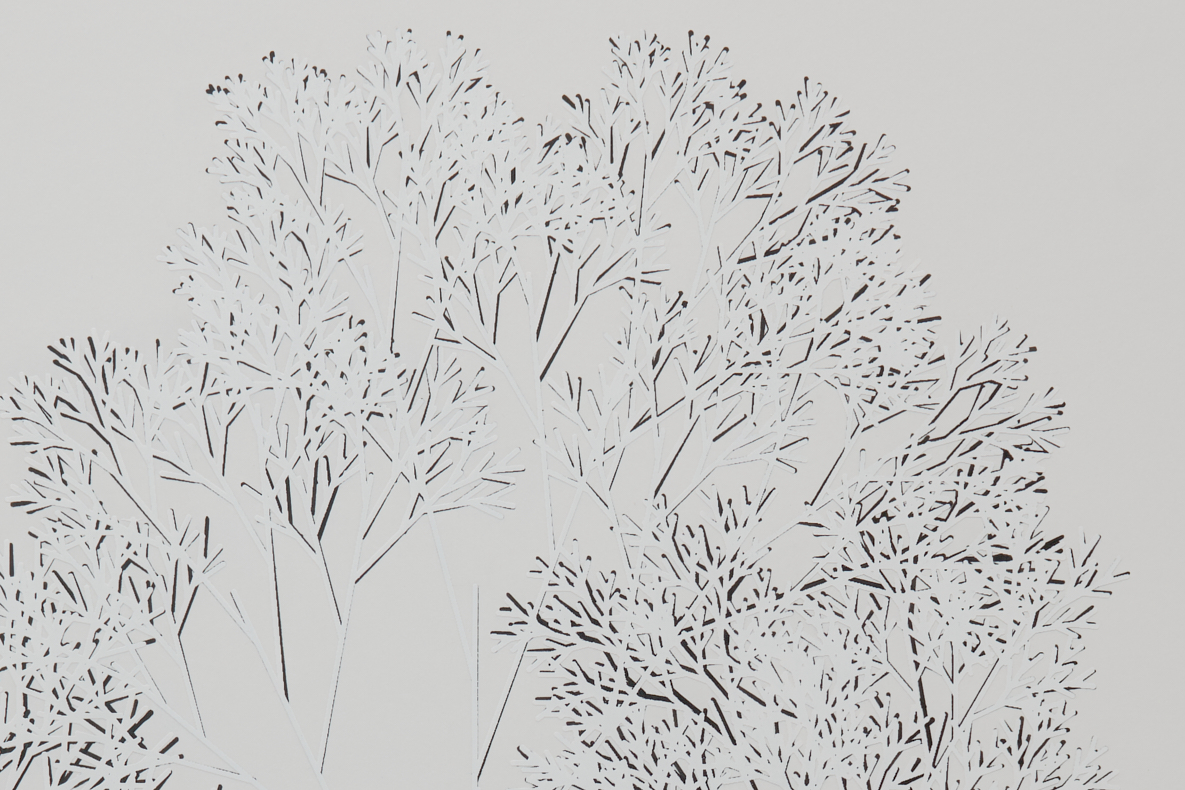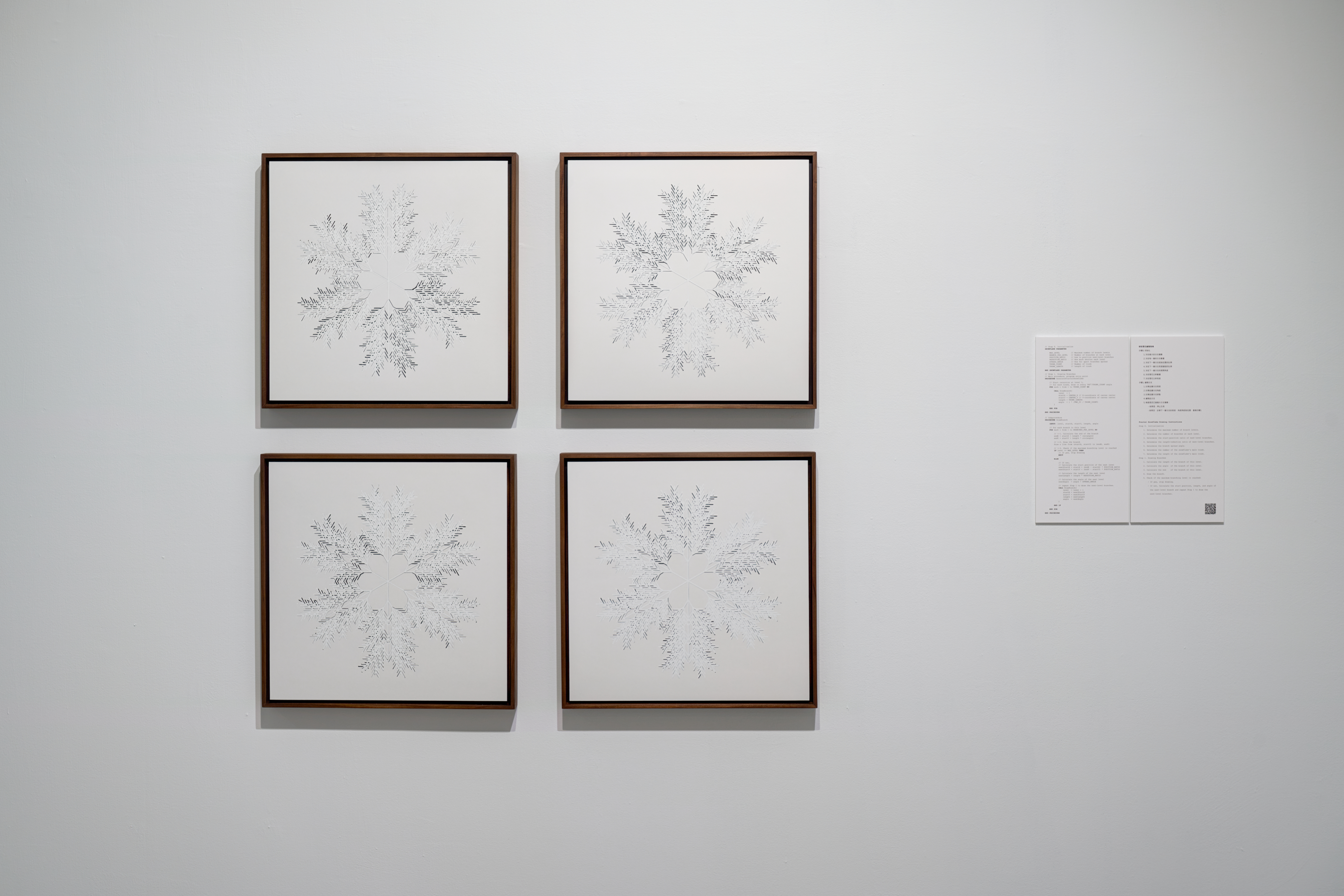Residual Noise
Technical pen and silkscreen
38 x 38 cm
2025
噪聲殘影
針筆、絹板
38 x 38 cm
2025
︎ Magic Noise: How AI Wanders in the Latent Space, LIN & LIN Gallery
︎ 神奇的雜訊:AI的潛在漫步方式,大未來林舍畫廊
![]()
《 噪聲殘影 》 樹系列
The work employs a method called “Vibe Coding” to generate prompts for AI, producing programs capable of drawing fractal patterns found in nature—such as branches and snowflakes. Using the same drawing rules, the artist first hand-renders the patterns in black lines on paper, then applies silkscreen printing to overlay the AI-generated version in white lines atop the hand-drawn image.
Because the computer’s precise white lines cannot perfectly cover the subtle irregularities of the hand-drawn black ones, traces of disorder remain visible. Through this subtractive process—between manual drawing and silkscreen overlay—the artist “calculates” the imperfections of human gesture, using these residual, chaotic lines to reflect on the abstract meaning of “noise” introduced by generative AI as it wanders through latent space.
本作品透過氛圍編碼(Vibe Coding)給AI提示詞的方式,生成可以繪製大自然中的碎形圖案——樹枝、雪花的程式。接著使用相同的繪製規則,手工以黑色線條畫在圖紙上,再以絹板印刷的方式,將電腦繪製的圖案以白色線條覆蓋在手繪的黑色線條上。電腦精準繪製的白色線條無法覆蓋具有手繪誤差的黑色線條,因而留下隱約可見的雜亂線條。藝術家藉由手繪與絹板的「減法」過程,「計算」人為的不精確性,並透過這些留下的雜亂線條,試圖回應生成式AI在潛空間探索時,加入「雜訊」所蘊含的抽象意義。
![]()
![]()
《噪聲殘影》樹系列,展場紀錄
![]()
《噪聲殘影》雪花系列,展場紀錄
![]()
![]()
《噪聲殘影》雪花系列,展場紀錄
Process Details
1. Image Generation: Using a large language model with a Vibe Coding approach, the artist generates programs capable of drawing natural fractal geometries such as tree branches and snowflakes.
2. Code Translation: The generated program is then translated into human-readable rules and steps, including precise parameters such as branching angles, length ratios, and positional relationships.
3. Custom Drawing Tools: Special triangular rulers with specific angles and lengths are custom-made.
4. Drawing: Following the translated rules and steps, the artist draws with technical pens of constant line width, minimizing human error as much as possible.
5. Screen Preparation: The AI-generated image is printed via inkjet and exposed to produce a silkscreen stencil.
6. Registration and Printing: The first hand-drawn stroke serves as the reference point for alignment, and the silkscreen image is printed precisely over the drawing.
詳細步驟
1. 生成影像: 透過大型語言模型,使用氛圍編碼的方式,生成可以繪製大自然中的碎形幾何圖案——樹枝、雪花的程式。
2. 轉譯程式碼 : 將該程式轉譯成人類可閱讀的規則與步驟,包含詳細的分支角度、長度比例、位置等等。
3. 訂製繪圖工具 : 訂製特殊角度與長度的三角板。
4. 繪製 : 依照轉譯後規則與步驟,使用粗細不會有變化的針管筆繪製,盡可能地減少誤差。
5. 製版 : 將程式生成的影像透過噴墨、曝光,製作絲絹網板。
6.對位與印刷 : 以繪製的第一個筆劃作為原點對位,並進行絹板印刷。
Special Thanks
Lin & Lin Gallery
Siyat Moses — Silkscreen Production
特別感謝
大未來林舍畫廊
阮原閩 版畫絹印製作
Technical pen and silkscreen
38 x 38 cm
2025
噪聲殘影
針筆、絹板
38 x 38 cm
2025
︎ Magic Noise: How AI Wanders in the Latent Space, LIN & LIN Gallery
︎ 神奇的雜訊:AI的潛在漫步方式,大未來林舍畫廊

《 噪聲殘影 》 樹系列
The work employs a method called “Vibe Coding” to generate prompts for AI, producing programs capable of drawing fractal patterns found in nature—such as branches and snowflakes. Using the same drawing rules, the artist first hand-renders the patterns in black lines on paper, then applies silkscreen printing to overlay the AI-generated version in white lines atop the hand-drawn image.
Because the computer’s precise white lines cannot perfectly cover the subtle irregularities of the hand-drawn black ones, traces of disorder remain visible. Through this subtractive process—between manual drawing and silkscreen overlay—the artist “calculates” the imperfections of human gesture, using these residual, chaotic lines to reflect on the abstract meaning of “noise” introduced by generative AI as it wanders through latent space.
本作品透過氛圍編碼(Vibe Coding)給AI提示詞的方式,生成可以繪製大自然中的碎形圖案——樹枝、雪花的程式。接著使用相同的繪製規則,手工以黑色線條畫在圖紙上,再以絹板印刷的方式,將電腦繪製的圖案以白色線條覆蓋在手繪的黑色線條上。電腦精準繪製的白色線條無法覆蓋具有手繪誤差的黑色線條,因而留下隱約可見的雜亂線條。藝術家藉由手繪與絹板的「減法」過程,「計算」人為的不精確性,並透過這些留下的雜亂線條,試圖回應生成式AI在潛空間探索時,加入「雜訊」所蘊含的抽象意義。


《噪聲殘影》樹系列,展場紀錄

《噪聲殘影》雪花系列,展場紀錄


《噪聲殘影》雪花系列,展場紀錄
Process Details
1. Image Generation: Using a large language model with a Vibe Coding approach, the artist generates programs capable of drawing natural fractal geometries such as tree branches and snowflakes.
2. Code Translation: The generated program is then translated into human-readable rules and steps, including precise parameters such as branching angles, length ratios, and positional relationships.
3. Custom Drawing Tools: Special triangular rulers with specific angles and lengths are custom-made.
4. Drawing: Following the translated rules and steps, the artist draws with technical pens of constant line width, minimizing human error as much as possible.
5. Screen Preparation: The AI-generated image is printed via inkjet and exposed to produce a silkscreen stencil.
6. Registration and Printing: The first hand-drawn stroke serves as the reference point for alignment, and the silkscreen image is printed precisely over the drawing.
詳細步驟
1. 生成影像: 透過大型語言模型,使用氛圍編碼的方式,生成可以繪製大自然中的碎形幾何圖案——樹枝、雪花的程式。
2. 轉譯程式碼 : 將該程式轉譯成人類可閱讀的規則與步驟,包含詳細的分支角度、長度比例、位置等等。
3. 訂製繪圖工具 : 訂製特殊角度與長度的三角板。
4. 繪製 : 依照轉譯後規則與步驟,使用粗細不會有變化的針管筆繪製,盡可能地減少誤差。
5. 製版 : 將程式生成的影像透過噴墨、曝光,製作絲絹網板。
6.對位與印刷 : 以繪製的第一個筆劃作為原點對位,並進行絹板印刷。
Special Thanks
Lin & Lin Gallery
Siyat Moses — Silkscreen Production
特別感謝
大未來林舍畫廊
阮原閩 版畫絹印製作